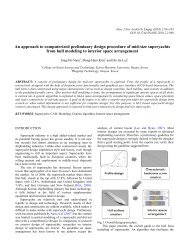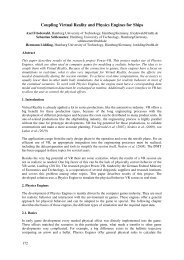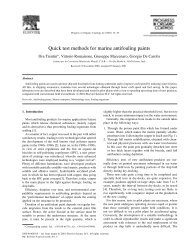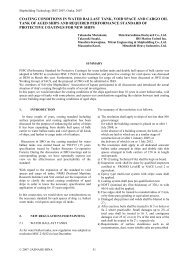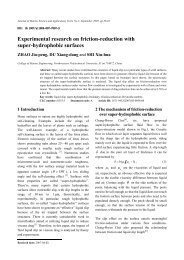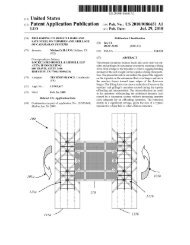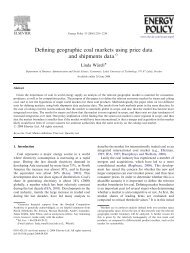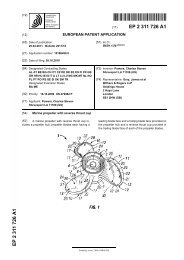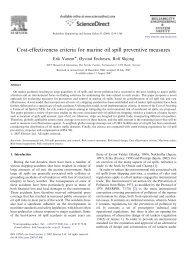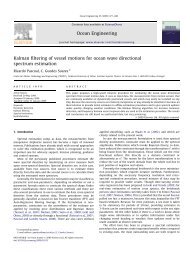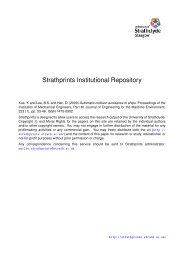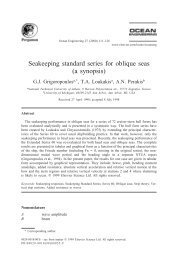Buckling of thin-walled conical shells under uniform external pressure
Buckling of thin-walled conical shells under uniform external pressure
Buckling of thin-walled conical shells under uniform external pressure
Create successful ePaper yourself
Turn your PDF publications into a flip-book with our unique Google optimized e-Paper software.
Thin-Walled Structures 46 (2008) 516–529<br />
<strong>Buckling</strong> <strong>of</strong> <strong>thin</strong>-<strong>walled</strong> <strong>conical</strong> <strong>shells</strong> <strong>under</strong> <strong>uniform</strong> <strong>external</strong> <strong>pressure</strong><br />
Abstract<br />
B.S. Golzan a , H. Showkati b,<br />
a Department <strong>of</strong> Civil Engineering, Urmia University, Urmia, Iran<br />
b Engineering Faculty, University <strong>of</strong> Urmia, Urmia, Iran<br />
Received 7 May 2007; received in revised form 18 October 2007; accepted 18 October 2007<br />
Available online 20 February 2008<br />
Shells are for the most part the deep-seated structures in manufacturing submarines, missiles, tanks and their ro<strong>of</strong>s, and fluid<br />
reservoirs; therefore it is a matter <strong>of</strong> concern to bring about some basic regulations associated with the existing codes. Above all,<br />
truncated <strong>conical</strong> <strong>shells</strong> (frusta) and shallow <strong>conical</strong> caps (SCC) subjected to <strong>external</strong> <strong>uniform</strong> <strong>pressure</strong> when discharging liquids or wind<br />
loads are discussed closely in this paper concerning and thrashing out their empirical nonlinear responses along with envisaging<br />
numerical methods in contrast. The buckling aptitude <strong>of</strong> <strong>shells</strong> is contingent upon two leading geometric ratios <strong>of</strong> ‘‘slant-length to<br />
radius’’ (L/R) and ‘‘radius to thickness’’ (R/t). In this paper, developing six frusta and four shallow cap specimens and their relevant FE<br />
models, use is made <strong>of</strong> laboratory modus operandi to enumerate buckling elastic and plastic responses and asymmetric imperfection<br />
sensitivity, whose adequacy has been reckoned through comparisons with arithmetical and numerical data correspondingly. These<br />
obtained upshots were aimed at validating and generalizing the data for unstiffened truncated cones and SCC in full scale.<br />
r 2007 Elsevier Ltd. All rights reserved.<br />
Keywords: Truncated <strong>conical</strong> <strong>shells</strong> (frusta); Shallow <strong>conical</strong> caps (SCC); <strong>Buckling</strong>; Sole-fish buckling; Postbuckling; Nonlinear response; External<br />
<strong>uniform</strong> <strong>pressure</strong><br />
1. Introduction<br />
Performing test on manufactured specimens is the most<br />
steadfast method in engineering researches. <strong>Buckling</strong> <strong>of</strong> a<br />
general <strong>conical</strong> shell depends on scores <strong>of</strong> variables, for<br />
instance, the geometric properties <strong>of</strong> the shell (the cone<br />
semi-vertex angle, the base radius, the slant length <strong>of</strong> the<br />
shell and the thickness), the material properties (isotropic,<br />
composite, laminated, etc.), and the type <strong>of</strong> the applied<br />
load (axial compression, hydrostatic or <strong>uniform</strong> <strong>pressure</strong>,<br />
torsion and combined load). The various parameters<br />
change the buckling behavior <strong>of</strong> the shell, making it<br />
difficult to achieve a general depiction. Due to the<br />
relatively high slenderness <strong>of</strong> the specimens, the failure is<br />
in all cases significantly influenced by plasticity effects. The<br />
elastic buckling behavior <strong>of</strong> unstiffened cones <strong>under</strong><br />
compression has been the subject <strong>of</strong> early analytical studies<br />
based on linear theory, in which axisymmetric elastic<br />
buckling was investigated.<br />
Corresponding author. Tel.: +98 914 141 1065; fax: +98 441 277 7022.<br />
E-mail address: h.showkati@mail.urmia.ac.ir (H. Showkati).<br />
0263-8231/$ - see front matter r 2007 Elsevier Ltd. All rights reserved.<br />
doi:10.1016/j.tws.2007.10.011<br />
ARTICLE IN PRESS<br />
www.elsevier.com/locate/tws<br />
These structures encompass light weight with high<br />
strength in different industrial applications. The significance<br />
is largely due to their widespread use in tanks and<br />
silos [1], <strong>of</strong>fshore structures, aeronautical and aerospace<br />
technology, ship and submarine hulls [2], pipelines and<br />
industrial chemical plants [3,4].<br />
The critical aptitude <strong>of</strong> frusta and SCC <strong>shells</strong> <strong>under</strong><br />
<strong>uniform</strong> <strong>external</strong> <strong>pressure</strong> is contingent upon geometric<br />
slenderness ratio <strong>of</strong> their slant length to radius (L/R) and<br />
radius to thickness (R/t).<br />
There is not enough literature devoted to the analysis<br />
<strong>of</strong> geometrically imperfect <strong>conical</strong> <strong>shells</strong>. Koiter’s general<br />
postbuckling theory provides a basis for analysis <strong>of</strong><br />
geometric imperfection sensitivity. All <strong>of</strong> these imperfection<br />
analyses were done on the <strong>shells</strong> <strong>of</strong> constant thickness.<br />
Ansourian [5] presented simplified design method about<br />
imperfections and boundary constraint effects on <strong>shells</strong><br />
subjected to wind loading. Holst et al. [6] investigated the<br />
method <strong>of</strong> considering the strains resulted from fabrication<br />
misfit <strong>of</strong> perfect and imperfect <strong>shells</strong> to attain equivalent<br />
residual stresses. Shen and Chen [7] studied buckling and<br />
postbuckling behavior <strong>of</strong> perfect and imperfect <strong>shells</strong> with
finite length which were subjected to combined axial and<br />
<strong>external</strong> <strong>pressure</strong>. They showed that this behavior is<br />
dependant on geometry, loading and initial imperfections.<br />
Also Yamaki [8] has studied the nonlinear behavior <strong>of</strong><br />
<strong>external</strong>ly pressurized cylindrical <strong>shells</strong> and effects <strong>of</strong><br />
geometrical imperfections. Further, other authors have<br />
studied stability <strong>of</strong> the <strong>shells</strong> that are outlined in the<br />
perspective to come.<br />
Performing test on manufactured specimens is the most<br />
steadfast method in engineering researches. In this paper,<br />
six frusta and four shallow <strong>conical</strong> cap (SCC) specimens<br />
have been manufactured and tested <strong>under</strong> the effect <strong>of</strong><br />
<strong>uniform</strong> <strong>external</strong> <strong>pressure</strong>. The material consisted <strong>of</strong> mild<br />
steel with yield stress <strong>of</strong> 277 MPa [9]. Boundary conditions<br />
are all simply supported in which only a radial constraint is<br />
provided at the edges. A loading <strong>of</strong> <strong>uniform</strong> <strong>external</strong><br />
<strong>pressure</strong> is produced by gauged vacuum pump using<br />
suction process. The stages <strong>of</strong> prebuckling, initial buckling,<br />
overall buckling and collapse have been observed and<br />
evaluated and nonlinear response <strong>of</strong> these <strong>conical</strong> <strong>shells</strong> has<br />
been studied.<br />
2. Experimental syllabus<br />
2.1. Model size<br />
In deciding on the model size for testing, a number <strong>of</strong><br />
issues were considered. Firstly, the models should not be<br />
too large, to avoid any undesirable inconveniences<br />
associated with laboratory testing. Secondly, the models<br />
should not be too small, so as to cause difficulties in their<br />
fabrication. Thirdly, the radius-to-thickness ratios (R/t) <strong>of</strong><br />
the models should be analogous to those used in realistic<br />
structures, since the effect <strong>of</strong> interaction between yielding<br />
and buckling needs to be appropriately captured in the<br />
tests. Typical real values for the R/t ratio are wi<strong>thin</strong> the<br />
range <strong>of</strong> 300–1000. As <strong>thin</strong> steel sheets <strong>of</strong> 0.5 mm and<br />
above can be easily obtained, welded or soldered effortlessly<br />
to produce high quality models with special welding<br />
machine or soldering apparatus, it was decided that the<br />
models ought to be <strong>of</strong> 600 mm in diameter. Consequently,<br />
Table 1<br />
Dimensions and aspect ratios <strong>of</strong> the specimens<br />
Specimen code Thickness t<br />
(mm)<br />
ARTICLE IN PRESS<br />
B.S. Golzan, H. Showkati / Thin-Walled Structures 46 (2008) 516–529 517<br />
Top radius<br />
(mm)<br />
Bottom radius<br />
(mm)<br />
proper (R/t) ratios can be achieved with different steel<br />
sheet thicknesses.<br />
2.2. Test specimens<br />
In this paper, six different frusta specimens were used,<br />
namely SC1, SC2, SC3, SC4, SC5, SC6 along with four<br />
SCC specimens represented by SCC1, SCC2, SCC3,<br />
and SCC4. . The properties <strong>of</strong> all models are outlined in<br />
Table 1. The thickness <strong>of</strong> specimens is totally constant. The<br />
frusta specimens have the same lower base diameter <strong>of</strong><br />
600 mm whereas the top base <strong>of</strong> the first three measures<br />
200 mm in diameter and in the second three it is 100 mm.<br />
The SCC specimens have the same lower base diameter <strong>of</strong><br />
600 mm except for SCC3 with a base diameter equal to<br />
500 mm. For the detailed geometry and slenderness ratios<br />
<strong>of</strong> specimens refer to Table 1. Edge conditions are all<br />
simply supported, in which only radial restraint was<br />
provided.<br />
Three tensile coupon tests were performed identically to<br />
obtain the properties <strong>of</strong> material. The yield and failure<br />
stresses <strong>of</strong> this mild steel are 277 and 373 Mpa, correspondingly.<br />
The Young modulus acquired, equals 210 GPa.<br />
Each specimen was assembled by cord-oriented welding<br />
over the rolled sheet fragment edges, as is shown in Fig. 1.<br />
A loading <strong>of</strong> <strong>uniform</strong> <strong>external</strong> <strong>pressure</strong> is produced by<br />
gauged vacuum pump using suction process.<br />
2.3. Fabrication modus operandi<br />
An important issue in shell buckling experiments is the<br />
fabrication <strong>of</strong> good quality specimens, including the choice<br />
<strong>of</strong> material and fabrication method. Many fabrication<br />
techniques have been developed [10,11], among which are<br />
electr<strong>of</strong>orming (making duplicates by electroplating metal<br />
onto a mold <strong>of</strong> an object, then removing the mold in which<br />
the intricate surface details are precisely reproduced by this<br />
process), thermal forming <strong>of</strong> plastics (PVC, polyethylene,<br />
Lexan, or other materials) and cold working <strong>of</strong> metal<br />
(spinning, explosive forming, or hydr<strong>of</strong>orming). Most <strong>of</strong><br />
these are specialized laboratory techniques for fabricating<br />
nearly perfect model <strong>shells</strong>. Where tests are intended to<br />
Height h<br />
(mm)<br />
Semi-vertex<br />
angle (a)<br />
R/t R/r L/R L ¼ slant<br />
length<br />
SC1 0.6 100 300 223.6 41.81 500 3 1<br />
SC2 0.6 100 300 403.2 26.36 500 3 1.5<br />
SC3 0.6 100 300 565.7 19.47 500 3 2<br />
SC4 0.6 50 300 165.8 56.44 500 6 1<br />
SC5 0.6 50 300 374.2 33.75 500 6 1.5<br />
SC6 0.6 50 300 545.4 24.62 500 6 2<br />
SCC1 0.5 – 300 60 78.69 600 – 1.02<br />
SCC2 0.8 – 300 60 78.69 375 – 1.02<br />
SCC3 0.5 – 250 62.5 75.96 500 – 1.03<br />
SCC4 0.8 – 300 75 75.96 375 – 1.03
518<br />
Fig. 1. Sector cutting process and slant length weld lines.<br />
duplicate full-scale steel shell construction as closely as<br />
possible, the method <strong>of</strong> rolling <strong>thin</strong> steel sheets followed by<br />
seam welding has been commonly used (e.g. [12–16]).<br />
Another method in seam fusing is soldering the seams that<br />
resulted in a good upshot both in manufacturing and testing<br />
processes and inspired a good prognostication <strong>of</strong> welds’<br />
performances. This method was adopted in the present work.<br />
2.4. Process <strong>of</strong> model fabrication<br />
To build the <strong>conical</strong> shell, it is first made by cutting and<br />
rolling a plate into the desired shape and soldering the<br />
meridional seams. Sheet cutting in the present work is done<br />
using a manually controlled shears and stonecutter cutting<br />
installation. A ‘‘beam compass’’, Fig. 1, consisting <strong>of</strong> a<br />
precisely machined aluminum strip with two end units was<br />
employed for quality sector cutting. One end unit is<br />
equipped with a small bearing to center the required circle<br />
at a small hole pre-drilled on the sheet and the other end<br />
unit is used to position the tip <strong>of</strong> the liner. Circles <strong>of</strong><br />
different sizes can be obtained by using aluminum strips <strong>of</strong><br />
different lengths. Accordingly, sectors can be obtained with<br />
a cutting accuracy wi<strong>thin</strong> 70.1 mm.<br />
ARTICLE IN PRESS<br />
B.S. Golzan, H. Showkati / Thin-Walled Structures 46 (2008) 516–529<br />
It is quite intricate to obtain clear-cut <strong>conical</strong> shapes<br />
using the manual rolling process since a number <strong>of</strong> <strong>thin</strong>gs<br />
have to be carefully controlled during the process. Firstly, a<br />
small angle (the dip angle) is required between the axis <strong>of</strong><br />
the top roll and those <strong>of</strong> the lower rolls. Secondly, the<br />
rolling speed should be smaller at the small end than that at<br />
the large end <strong>of</strong> the cone. Consequently, special heed is<br />
required during the cone rolling process and the same<br />
modus operandi needs to be recurring a few times until the<br />
desired shape is achieved. Many radial lines were drawn on<br />
the panel. Such lines have to be kept parallel to the axes <strong>of</strong><br />
the rolls when the lines pass through the rolls. To weld<br />
together the shell components is another arduous task. The<br />
meagerness <strong>of</strong> the models insinuates that special concern is<br />
required in assembling these models to guarantee that the<br />
weld or solder is sturdy enough so that structural failure<br />
precedes joint malfunction, and that the level and form <strong>of</strong><br />
geometric imperfections bear some resemblance to those in<br />
real structures.<br />
3. Empirical set-up<br />
3.1. SCC testing system<br />
Fig. 2 shows an overall view <strong>of</strong> the experimental set-up<br />
for SCC specimens. Concerning the application <strong>of</strong> this<br />
machine, we coined the name ‘‘machine <strong>of</strong> detection and<br />
investigation <strong>of</strong> yield-lines and failure in bending behavior<br />
<strong>of</strong> steel plates and <strong>shells</strong>’’ that was invented by the authors<br />
in the preceding year to come up with some empirical<br />
features in accordance with the plates and <strong>conical</strong> <strong>shells</strong><br />
with different shapes and aspect ratios. The full guide and<br />
explanation to this machine has been presented in another<br />
paper and is not the issue <strong>of</strong> concern in this study.<br />
The base brink <strong>of</strong> the model junction is placed in the<br />
groove <strong>of</strong> a rigid circular rim, which in turn sits on vertical<br />
Fig. 2. View <strong>of</strong> test rig for the cap specimens.
supports. To ensure that the brink is properly tenable in the<br />
groove it is covered by a grooved rubber and both the<br />
groove <strong>of</strong> rubber and the rim is filled with silicone sealant.<br />
Then connecting the vacuum pump to the rig the process <strong>of</strong><br />
air suction is conducted <strong>under</strong> the specimen. This trend is<br />
performed in such a way that the loading is exerted<br />
incrementally and in all stages every <strong>thin</strong>g is <strong>under</strong> the very<br />
control so that the specimen is not destroyed abruptly to<br />
not let us study the process hesitantly and exhaustively.<br />
3.2. Frusta testing system<br />
The test rig <strong>of</strong> the frusta specimens is composed <strong>of</strong> two<br />
parts (Fig. 3), which was invented by the authors. The first<br />
part is designed to hold the test specimen at the desired place,<br />
which is composed <strong>of</strong> two rigid circular grooved plates.<br />
These grooves are entrenched in both sides <strong>of</strong> specimen.<br />
Four threaded long bars are provided to adjust the plates for<br />
the specimen height. The second part <strong>of</strong> the rig consisted <strong>of</strong> a<br />
small platform to be used for installation <strong>of</strong> vacuum pump.<br />
This pump is employed to generate <strong>uniform</strong> <strong>external</strong> <strong>pressure</strong><br />
over the shell surface. Careful measurements <strong>of</strong> the test<br />
results were done by six circumferentially and meridionaly<br />
mounted strain gauges, a manometer and four transducers.<br />
All collected data were processed using a data logger and a<br />
s<strong>of</strong>tware named UCAM-20PC.<br />
3.2.1. Setting up the frusta<br />
The upper and lower brinks <strong>of</strong> the frusta were covered<br />
by grooved rubber and then silicon glue was used over all<br />
openings to prevent any possible air seepage during the<br />
suction process. The frusta were placed on the lower<br />
grooved rigid plate. For specimens SC1 and SC4, as the<br />
slant <strong>of</strong> their inclined surfaces exceeded far more than<br />
vertical position, they could luxate from the grooves; so a<br />
special ring truncated on the edges equal to the slant <strong>of</strong> the<br />
surfaces was employed to not let the frusta edges luxate<br />
outwardly in case <strong>of</strong> higher loading and disarticulation.<br />
For the top edges, as there is liability to luxate inwardly,<br />
another specific round plate chamfered inwardly at the<br />
edges is located to prop up this susceptible location<br />
(Fig. 3). Using four threaded bars, the upper plate was<br />
Supporting ring<br />
Fig. 3. View <strong>of</strong> the frusta test rig and chamfered ring to support the lateral<br />
luxating <strong>of</strong> edges.<br />
ARTICLE IN PRESS<br />
B.S. Golzan, H. Showkati / Thin-Walled Structures 46 (2008) 516–529 519<br />
placed exactly over the top edge <strong>of</strong> the frusta in which the<br />
simply supported boundary conditions were geared up at<br />
both trimmings. The modification nuts could foil any axial<br />
load to be applied to the specimens. On the top plate, three<br />
holes were drilled for the purpose <strong>of</strong> air suction,<br />
manometer installation and air release valve assembly to<br />
control the rate <strong>of</strong> loading and unloading on shell<br />
specimens. The produced <strong>pressure</strong> was measured by the<br />
above-mentioned monometer. Fig. 3 shows a total view <strong>of</strong><br />
test provision.<br />
3.3. Measurement <strong>of</strong> imperfections and deformations<br />
<strong>Buckling</strong> <strong>of</strong> <strong>shells</strong> is generally known to be sensitive to<br />
geometric imperfections; so precise surveys <strong>of</strong> initial<br />
geometric imperfections are an essential step in any high<br />
quality shell buckling experiments. In addition, it is also<br />
desirable to have precise measurements <strong>of</strong> deformed shapes<br />
<strong>of</strong> the shell during its loading so that the buckling/collapse<br />
mode can be accurately determined and compared with<br />
theoretical predictions. Many shell imperfection measurement<br />
techniques have been developed [18]. LVDTs or other<br />
contacting probes were usually used in most <strong>of</strong> the earlier<br />
measurement systems [12,13]. For very <strong>thin</strong> <strong>shells</strong> with a<br />
relatively low transverse stiffness, the small probe force<br />
may induce distortions <strong>of</strong> the shell surface, so non-contact<br />
probes are favored.<br />
A simpler way has been applied in the present measurement<br />
system for appraising both initial imperfections and<br />
displacements. Seeing that the complete measurements <strong>of</strong> a<br />
<strong>conical</strong> surface require a three-dimensional survey <strong>of</strong> the<br />
radial, circumferential and meridional coordinates, manual<br />
scanning was implemented as the measurement technique.<br />
At first a number <strong>of</strong> meridians were drawn on the<br />
expanded surfaces <strong>of</strong> the cones at specified degrees, and<br />
then they were assembled, conducting their meridional<br />
joints. After fabricating, circumferential segments were<br />
segregated on the surface and then the cone was installed in<br />
its place. Subsequently, at the contiguous <strong>of</strong> each meridian<br />
a ruler was mounted and another ruler was employed to<br />
measure the horizontally projected distance between nodes<br />
<strong>of</strong> drawn meshes and the edge <strong>of</strong> the specimens identified<br />
by the ruler rim. In each node <strong>of</strong> obtained mesh, three<br />
coordinates <strong>of</strong> r, y and z are measured carefully in all<br />
specimens. Therefore, a real geometry <strong>of</strong> shell is obtained<br />
and then is used in finite element modeling <strong>of</strong> the structure<br />
for further comparative analyses.<br />
Despite the relatively stocky geometry <strong>of</strong> the specimens,<br />
initial geometric imperfections were recorded on all specimens,<br />
with the method and mesh outlined above. In order to<br />
render these measurements functional for comparative<br />
studies and numerical modeling, the unrefined imperfections<br />
were subjected to some data processing techniques that<br />
enable the identification <strong>of</strong> dominant modes and facilitate<br />
comparisons <strong>of</strong> imperfections with observed buckling and<br />
collapse modes. Fig. 4 shows typical imperfection layouts for<br />
some <strong>of</strong> the models, (inward/outward) in two different views.
520<br />
It is worth bearing in mind that the measured imperfections<br />
on the models are too large and this is attributed to the small<br />
scale <strong>of</strong> the models but should be taken into account in<br />
correlating the experimental results with analytical and<br />
design dealings. The first geometric imperfections in the<br />
main lead to a considerable difference between theoretical<br />
and empirical consequences.<br />
A number <strong>of</strong> strain gauges were installed on the specimens,<br />
with some <strong>of</strong> them being used to measure circumferential<br />
strains and the others to measure meridional strains all<br />
over the specimens and near the weld transitions. The exact<br />
locations <strong>of</strong> circumferential (SH) and meridional (SV) strain<br />
gauges and transducers are provided in Table 3.<br />
It is worth saying that the difference in <strong>external</strong> <strong>pressure</strong> is<br />
less sensitive than that <strong>of</strong> axial loading. This is because <strong>of</strong><br />
postbuckling capacity, which is available in lateral <strong>pressure</strong>.<br />
4. Exhaustive executions <strong>of</strong> the tests<br />
The steps <strong>of</strong> test implementation were as follows:<br />
Installation and calibration <strong>of</strong> instrumental apparatus.<br />
Calculation <strong>of</strong> approximated critical buckling load by<br />
Jawad [19] equation to determine load steps all through<br />
the tests.<br />
ARTICLE IN PRESS<br />
B.S. Golzan, H. Showkati / Thin-Walled Structures 46 (2008) 516–529<br />
288<br />
270<br />
252<br />
306<br />
234<br />
324<br />
216<br />
342<br />
198<br />
300<br />
250<br />
200<br />
150<br />
100<br />
50<br />
0<br />
0<br />
180<br />
SCC4<br />
Fig. 4. Initial imperfection layout for SC3, SC6 and SCC4.<br />
18<br />
162<br />
Gauging initial geometric imperfections.<br />
Applying an initial <strong>external</strong> load up to approximately<br />
20% <strong>of</strong> calculated buckling load, and unloading for the<br />
purpose <strong>of</strong> system conditioning.<br />
Applying the <strong>external</strong> gradually increasing load to reach<br />
to initial buckling and ongoing until the incidence <strong>of</strong><br />
overall buckling and failure mode <strong>of</strong> shell is attained;<br />
Measuring all required records throughout the test<br />
progress.<br />
5. Failure behavior and potency<br />
Most <strong>of</strong> the circumferential strains were also similar<br />
and approximately proportional to the load in the initial<br />
stage <strong>of</strong> loading (Figs. 5(a) and (b)), indicating linear<br />
and dominantly axisymmetric behavior. However, a small<br />
number <strong>of</strong> circumferential strain gauges had different<br />
readings right from the beginning, which is attributable<br />
to the attendance <strong>of</strong> relatively large local imperfections<br />
close by. As the load increased, the strain readings at<br />
different locations gradually diverged from each other.<br />
This divergence is a reflection <strong>of</strong> the growth <strong>of</strong> nonsymmetric<br />
deformations. At a certain increment <strong>of</strong> the<br />
load, non-periodical deformations could be observed on<br />
36<br />
144<br />
54<br />
126<br />
72<br />
90<br />
108
the <strong>shells</strong> by naked eyes. These deformations continued to<br />
grow with further loading, leading to obvious buckles <strong>of</strong><br />
non-similar wavelengths. The development <strong>of</strong> these buckling<br />
lobes was associated with a reduction in the load<br />
carrying capacity as it led to some deformations at the<br />
radial base edge that caused seepage <strong>of</strong> the air. Explicitly,<br />
the specimens indicated a stable postbuckling path.<br />
Ultimate failure occurred by the formation <strong>of</strong> a plastic<br />
collapse mechanism with nearly non-<strong>uniform</strong> plastic<br />
deformations over a large part <strong>of</strong> the circumference that<br />
resulted in failure <strong>of</strong> the supports to sustain the proper<br />
function. Figs. 6 and 7 show the models after the failure.<br />
Table 2<br />
<strong>Buckling</strong> <strong>pressure</strong> and mode <strong>of</strong> the specimens<br />
Specimens <strong>Buckling</strong><br />
load<br />
obtained by<br />
experiments<br />
(KPa)<br />
<strong>Buckling</strong><br />
load<br />
obtained by<br />
FEA (KPa)<br />
<strong>Buckling</strong><br />
load<br />
obtained by<br />
Jawad<br />
equation<br />
(KPa)<br />
ARTICLE IN PRESS<br />
Mode<br />
numbers by<br />
experiments<br />
SC1 25 28 35.4 7 (skirt mode)<br />
SC2 20 25 32.3 7 (skirt mode)<br />
SC3 14 22 24.68 6 (skirt mode)<br />
SC4 20 27 24.1 6 (skirt mode)<br />
SC5 25 40 31.35 6 (skirt mode)<br />
SC6 21 35 27.27 6 (skirt mode)<br />
SCC1 5.7 6.2 3.83 Sole-fish mode<br />
SCC2 8 14.5 20.3 Sole-fish mode<br />
SCC3 7.5 13 4.02 Sole-fish mode<br />
SCC4 10 25 16.2 Sole-fish mode<br />
Table 3<br />
Layout <strong>of</strong> strain gauges and transducers on all specimens<br />
These results show that most <strong>of</strong> the buckles on the<br />
models were amplified from initial geometric imperfections<br />
(Fig. 4). The buckling load can be defined as the pinnacle<br />
load <strong>of</strong> a nonlinear load–displacement curve. Such a<br />
buckling load incorporates the effect <strong>of</strong> imperfections.<br />
For the in attendance models, the buckling load <strong>of</strong> the<br />
corresponding perfect structure is believed to be a good<br />
assess <strong>of</strong> its veracity, but the determination <strong>of</strong> buckling<br />
load is not straightforward. A rough approach may be, to<br />
take the load at which the strain readings started to<br />
diverge, the same as the buckling load. This, on the other<br />
hand, does not allocate a precise definition <strong>of</strong> the buckling<br />
load as the strain readings had some differences right from<br />
the beginning <strong>of</strong> loading due to the presence <strong>of</strong> initial<br />
imperfections. Another drawback <strong>of</strong> using strain readings<br />
is that due to the cost and installation considerations,<br />
normally, merely part <strong>of</strong> the cone circumference is installed<br />
with strain gauges. So the most sought-after locations <strong>of</strong><br />
strain measurements for buckling load determination may<br />
have been disregarded. For these reasons, the use <strong>of</strong><br />
displacements <strong>of</strong> the cones, which are appraised around the<br />
whole circumference in the current set-ups, is preferred for<br />
attaining the buckling loads.<br />
In Table 2, the buckling <strong>pressure</strong>s and modes <strong>of</strong> six<br />
frusta and four SCC specimens in diverse test stages are<br />
tabulated. Before initial buckling the behavior <strong>of</strong> shell<br />
is quite static with no pragmatic buckle lobe. As a<br />
comparison three obtained buckling loads from different<br />
approaches have been presented in this table. It is quite<br />
apparent that the experimental outcomes are taking up the<br />
lower range <strong>of</strong> load owing to the presence <strong>of</strong> initial<br />
Strain gauges Transducers<br />
SH1 horizontal<br />
gauge<br />
SV2 vertical<br />
gauge<br />
SH3 horizontal<br />
gauge<br />
SV4 vertical<br />
gauge<br />
SH5 horizontal<br />
gauge<br />
SV6 vertical<br />
gauge<br />
SC1 3061, 140 mm 2451, 110 mm 1501, 90 mm 1221, 60mm 541, 50mm 181, 80 mm 3121,<br />
90 mm<br />
SC2 771, 30mm 961, 350 mm 1341, 120 mm 1981, 220 mm 2581, 270 mm 3421, 170 mm 181,<br />
150 mm<br />
SC3 1901, 230 mm 2471, 385 mm 3071, 110 mm 81, 210 mm 691, 60 mm 1251, 310 mm 1501,<br />
310 mm<br />
SC4 1751, 120 mm 1751, 170 mm 1501, 70mm 481, 220 mm 3481, 50 mm 2641, 70 mm 2051,<br />
70 mm<br />
SC5 91, 120 mm 3511, 120 mm 2791, 30 mm 2421, 270 mm 1891, 120 mm 991, 320 mm 3421,<br />
70 mm<br />
SC6 8.51, 70mm 261, 170 mm 941, 270 mm 1631, 370 mm 2051, 95 mm 2911, 220 mm 3511,<br />
120 mm<br />
SCC1 3421, 30 mm 3061, 280 mm 2701, 120 mm 1621, 150 mm 1081, 30mm 541, 280 mm 3421,<br />
120 mm<br />
SCC2 3261, 80 mm 3401, 30 mm 1851, 130 mm 2751, 10mm 701, 20 mm 1231, 230 mm 3151,<br />
80 mm<br />
SCC3 511, 220 mm 2831, 220 mm 2311, 30 mm 2051, 120 mm 1771, 70mm 771, 120 mm 3471,<br />
70 mm<br />
SCC4 1081, 30 mm 1081, 288 mm 91, 120 mm 2971, 170 mm 2611, 285 mm 1891, 70 mm 1441,<br />
30 mm<br />
All distances are measured from the bigger base on the slant length.<br />
B.S. Golzan, H. Showkati / Thin-Walled Structures 46 (2008) 516–529 521<br />
T1 T2 T3 T4<br />
1441,<br />
190 mm<br />
431,<br />
100 mm<br />
1501,<br />
160 mm<br />
601,<br />
220 mm<br />
2881,<br />
220 mm<br />
171,<br />
170 mm<br />
2341,<br />
30 mm<br />
2251,<br />
20 mm<br />
2571,<br />
30 mm<br />
721,<br />
220 mm<br />
841, 3481,<br />
90 mm 90 mm<br />
2311, 3021,<br />
130 mm 50 mm<br />
2701, 3451,<br />
360 mm 210 mm<br />
3481, 2641,<br />
70 mm 120 mm<br />
1981, 1261,<br />
170 mm 120 mm<br />
1201, 2491,<br />
270 mm 220 mm<br />
901, 1261,<br />
70 mm 280 mm<br />
1691, 301,<br />
80 mm 230 mm<br />
Apex 1031,<br />
120 mm<br />
3061, 1441,<br />
285 mm 150 mm
522<br />
<strong>pressure</strong>(kpa)<br />
<strong>pressure</strong>(kpa)<br />
<strong>pressure</strong>(kpa)<br />
<strong>pressure</strong>(kpa)<br />
t1<br />
t2<br />
t3<br />
t4<br />
-22 -20 -18 -16 -14 -12 -10 -8 -6 -4 -2 0<br />
t1<br />
t2<br />
t3<br />
t4<br />
total deformation(mm)<br />
-21 -19 -17 -15 -13 -11 -9 -7 -5 -3 -1<br />
total deformation(mm)<br />
ARTICLE IN PRESS<br />
8<br />
6<br />
4<br />
2<br />
0<br />
7<br />
6<br />
5<br />
4<br />
3<br />
2<br />
1<br />
0<br />
14<br />
12<br />
10<br />
10<br />
9<br />
8<br />
7<br />
6<br />
5<br />
4<br />
<strong>pressure</strong>(kpa)<br />
<strong>pressure</strong>(kpa)<br />
sh5<br />
-0.002 -0.001 0 0.001 0.002 0.003<br />
0<br />
0.004<br />
sv2<br />
sv4<br />
sv6<br />
strain<br />
-0.0023 -0.0018 -0.0013 -0.0008 -0.0003<br />
t1<br />
t2<br />
t3<br />
t4<br />
3<br />
2<br />
1<br />
sh1<br />
sh3<br />
sh5<br />
2<br />
1<br />
0<br />
0<br />
-22 -20 -18 -16 -14 -12 -10 -8 -6 -4 -2 0 -0.002 -0.001 0 0.001 0.002 0.003 0.004 0.005 0.006<br />
total deformation(mm)<br />
t1<br />
t2<br />
4<br />
t3<br />
t4<br />
2<br />
0<br />
-19 -17 -15 -13 -11 -9 -7 -5 -3 -1<br />
total deformation(mm)<br />
B.S. Golzan, H. Showkati / Thin-Walled Structures 46 (2008) 516–529<br />
A<br />
A<br />
A<br />
A<br />
20<br />
18<br />
16<br />
14<br />
12<br />
10<br />
8<br />
6<br />
(i)<br />
(ii)<br />
<strong>pressure</strong>(kpa)<br />
(iii)<br />
<strong>pressure</strong>(kpa)<br />
(iv)<br />
strain<br />
strain<br />
-0.0035 -0.003 -0.0025 -0.002 -0.0015 -0.001 -0.0005 0<br />
Fig. 5. (a) SCC total deformation and strain values vs. <strong>pressure</strong>. (i) SSC1, (ii) SSC2, (iii) SSC3, (iv) SSC4 (b) load–deformation and load–strain graph for<br />
specimens SC1 and SC3 in different coordinates.<br />
sv2<br />
sv4<br />
sv6<br />
strain<br />
B<br />
B<br />
B<br />
B<br />
sh1<br />
sh3<br />
7<br />
6<br />
5<br />
4<br />
3<br />
2<br />
1<br />
12<br />
10<br />
8<br />
6<br />
4<br />
2<br />
0<br />
8<br />
7<br />
6<br />
5<br />
4<br />
3<br />
20<br />
18<br />
16<br />
14<br />
12<br />
10<br />
8<br />
6<br />
4<br />
2<br />
0
Digital transducer<br />
Failure area<br />
ARTICLE IN PRESS<br />
B.S. Golzan, H. Showkati / Thin-Walled Structures 46 (2008) 516–529 523<br />
Fig. 5. (Continued)<br />
Fig. 6. Failure modes <strong>of</strong> specimens SC5 and SC6.<br />
Digital strain gauge<br />
Wresting <strong>of</strong> apex point at the<br />
bifurcation
524<br />
geometrical imperfections, apparatus shortcomings and<br />
other human and instrument-related factors. On the other<br />
hand, for six frusta, taking into account both the buckling<br />
load obtained from FEA and the equation developed by<br />
Jawad it is noticed that for the first three specimens the<br />
latter amount <strong>of</strong> load exceeds the one that <strong>of</strong> the previous<br />
one whereas for the second three the outcome is completely<br />
vice versa. Bearing in mind that the all initial imperfections<br />
have been entered to FE models too, one can <strong>under</strong>stated<br />
that the results <strong>of</strong> the first three specimens are closer to<br />
reality than the second three; that is because the equation<br />
emanated by Jawad formulation is based on the transformed<br />
geometrical shape from cylinder to cone; and<br />
according to Table 2, (R/r) ratio for the first three is more<br />
similar to a cylinder than the second three which have a<br />
higher tapering ratio.<br />
ARTICLE IN PRESS<br />
B.S. Golzan, H. Showkati / Thin-Walled Structures 46 (2008) 516–529<br />
Fig. 7. General layout <strong>of</strong> failure by formation <strong>of</strong> plastic displacements in the circumference and supports.<br />
6. <strong>Buckling</strong> <strong>of</strong> <strong>conical</strong> <strong>shells</strong><br />
The derivation <strong>of</strong> the equations for the buckling <strong>of</strong><br />
<strong>conical</strong> <strong>shells</strong> is practically convoluted. The derivation<br />
for the buckling <strong>pressure</strong> <strong>of</strong> the cone, shown in Fig. 8,<br />
comprises obtaining expressions for the work carried out<br />
by the applied <strong>pressure</strong>, membrane forces, stretching <strong>of</strong> the<br />
middle surface and bending <strong>of</strong> the cone. The total work is<br />
then minimized to obtain a critical <strong>pressure</strong> expression.<br />
Seide [20] indicated that the buckling <strong>of</strong> a cone is affected<br />
by the function f (1 r/R) and is expressed as<br />
p cr ¼ ¯pf ð1 r=RÞ, (1)<br />
where ¯p is the <strong>pressure</strong> <strong>of</strong> equivalent cylinder as defined<br />
above, f the cone function as defined in Fig. 9.
p cr p<br />
125<br />
120<br />
115<br />
110<br />
105<br />
By various substitutions [19], it can be shown that Eq. (1)<br />
can be transferred to the form<br />
0:92Eðte=RÞ 25<br />
pcr ¼ , (2)<br />
Le=R<br />
where te is the effective thickness <strong>of</strong> cone t cos a; t the<br />
thickness <strong>of</strong> cone; and Le the effective length <strong>of</strong> cone L/2<br />
(1+r/R). Thus, <strong>conical</strong> <strong>shells</strong> subjected to <strong>external</strong><br />
<strong>pressure</strong> may be analyzed as cylindrical <strong>shells</strong> with an<br />
effective thickness and length.<br />
6.1. Sole-fish buckling mode<br />
Fig. 8. Parametric considerations.<br />
100 0 0.1 0.2 0.3 0.4 0.5 0.6 0.7 0.8 0.9 1.0<br />
1-r/R<br />
Fig. 9. Cone function.<br />
An important parameter in buckling analysis <strong>of</strong> axisymmetrically<br />
loaded <strong>shells</strong>, for instance, the models thrashed<br />
out herein, is the number <strong>of</strong> circumferential waves in the<br />
buckling mode layout. Notionally speaking, the buckling<br />
mode is in the form <strong>of</strong> a single harmonic mode around the<br />
circumference, but in a test, owing to the incidence <strong>of</strong><br />
imperfections, miscellaneous modes may be implicated. A<br />
well-established way <strong>of</strong> construing geometric imperfection<br />
and deformation measurements to decipher the dominant<br />
harmonic modes and their relationship is to carry out<br />
ARTICLE IN PRESS<br />
B.S. Golzan, H. Showkati / Thin-Walled Structures 46 (2008) 516–529 525<br />
Fourier decompositions. Such decompositions were not<br />
carried out for the imperfection or deformation measurements<br />
on these models, since the form <strong>of</strong> buckling that was<br />
developed all over the cones was drastically outlying from a<br />
well-ordered wave configuration. On such specimens there<br />
was an overall buckling predisposed by position <strong>of</strong> weld<br />
lines and efficiency <strong>of</strong> the supports and formation <strong>of</strong> the<br />
initial leakage point. So as to set forth a better depiction <strong>of</strong><br />
this buckling, principally based on empirical remarks and<br />
for the first time we coined the name ‘‘sole-fish buckling<br />
mode’’ on this phenomenon. The spine <strong>of</strong> this animal can<br />
better illustrate the weld line and its impact on the other<br />
parts <strong>of</strong> the shell. The appearance <strong>of</strong> non-periodical waves<br />
can be easily spotted from this plot.<br />
7. Observations and milestones<br />
7.1. Frusta specimens<br />
In Figs. 10 and 11 a contrast is carried out between<br />
initial and ultimate geometry <strong>of</strong> specimen SC5 in which the<br />
maximum deformation is located roughly at the height<br />
<strong>of</strong> 1<br />
3 h.<br />
In all <strong>shells</strong> <strong>of</strong> this study the loading was continued to<br />
farther than the range <strong>of</strong> postbuckling behavior. It is<br />
observed that a ‘‘V’’ shape yield line is developed in the<br />
region close to the restrained boundaries <strong>of</strong> the frusta,<br />
before failure takes place. The same phenomenon was<br />
reported by Showkati [21]. InFig. 6 a typical behavior is<br />
represented for specimen SC5 and SC6.<br />
By escalating the <strong>external</strong> <strong>pressure</strong>, the failure mode<br />
was gradually approached. In most specimens, incidence<br />
<strong>of</strong> a very large displacement in one edge caused an<br />
288<br />
270<br />
252<br />
306<br />
234<br />
324<br />
216<br />
342<br />
198<br />
300<br />
280<br />
260<br />
240<br />
220<br />
200<br />
180<br />
160<br />
140<br />
120<br />
100<br />
80<br />
60<br />
40<br />
20<br />
0<br />
0<br />
180<br />
18<br />
162<br />
36<br />
144<br />
54<br />
126<br />
Fig. 10. Polar plot <strong>of</strong> final geometry measured on specimen SC5.<br />
72<br />
90<br />
108
526<br />
radius<br />
250<br />
240<br />
230<br />
220<br />
210<br />
200<br />
190<br />
180<br />
170<br />
160<br />
150<br />
140<br />
130<br />
120<br />
110<br />
100<br />
90<br />
80<br />
70<br />
60<br />
50<br />
40<br />
30<br />
20<br />
10<br />
0<br />
Radius (mm)<br />
204<br />
201<br />
198<br />
195<br />
192<br />
189<br />
186<br />
183<br />
180<br />
177<br />
174<br />
171<br />
168<br />
unmanageable outflow on vacuum function and then the<br />
test was impeded. Fig. 6 shows plainly the breakdown <strong>of</strong><br />
frusta SC5 and SC6.<br />
It is worth noting in <strong>external</strong>ly pressurized frusta <strong>shells</strong><br />
that the inward deformations are as well, larger than<br />
outward ones. Comparable geometries <strong>of</strong> this fact in<br />
specimen SC5 and SCC1 have been plotted in Figs. 11<br />
and 12. Graphs <strong>of</strong> load–deformation and load–strain paths<br />
<strong>of</strong> specimens SC1 and SC3 are presented in Fig. 5(b) for<br />
buckling and postbuckling stages.<br />
In this experimental study it is observed that the longer<br />
<strong>shells</strong> have more deformation and lesser buckling load than<br />
shorter ones.<br />
ARTICLE IN PRESS<br />
B.S. Golzan, H. Showkati / Thin-Walled Structures 46 (2008) 516–529<br />
buckled form<br />
initial imperfection<br />
0 18 36 54 72 90 108 126 144 162 180 198 216 234 252 270 288 306 324 342 360<br />
Degree<br />
Fig. 11. Initial and ultimate radial deformations in SC5 at the height <strong>of</strong> 141.4 mm.<br />
Initial imperfection<br />
Buckled layout<br />
0 20 40 60 80 100 120 140 160 180 200 220 240 260 280 300 320 340 360<br />
degree<br />
Fig. 12. Initial imperfection and buckled form <strong>of</strong> SCC1.<br />
As another comparison Fig. 13 shows the diversity in<br />
behavior between experimental and FEA methods for two<br />
specimens SC1 and SC4.<br />
7.1.1. Yield line wresting<br />
As shown in Fig. 6 in specimens SC5 and SC6 along<br />
with an increase in <strong>pressure</strong> at first, initial buckling<br />
lobes were formed, then up hilling the load general<br />
deformation developed in the whole body <strong>of</strong> the specimens<br />
to the extent that all lobes were complete. Exceeding<br />
the ultimate buckling load and as we neared the failure<br />
load the climax <strong>of</strong> some <strong>of</strong> the ‘‘V’’ shape yield lines<br />
that were formed began to wrest. This trend kept
acting until the bifurcation point at the apex <strong>of</strong> two<br />
or three yield lines caused resurgence <strong>of</strong> buckling lobes<br />
in the opposite side <strong>of</strong> the frusta and eventually it<br />
led to complete failure <strong>of</strong> one side <strong>of</strong> the frusta which<br />
took place in the supporting point with luxating the lower<br />
edge.<br />
7.2. SCC specimens<br />
SC1<br />
In Fig. 12 a contrast is carried out between initial and<br />
ultimate geometry <strong>of</strong> test specimen SCC1 in which the<br />
utmost deformation is positioned at the height <strong>of</strong> 1<br />
4L <strong>of</strong> the<br />
specimen.<br />
ARTICLE IN PRESS<br />
-10 -9 -8 -7 -6 -5 -4 -3 -2 -1<br />
SC4<br />
FEA<br />
Expev<br />
FEA<br />
Exper.<br />
B.S. Golzan, H. Showkati / Thin-Walled Structures 46 (2008) 516–529 527<br />
Radial displacement (mm)<br />
-10 -9 -8 -7 -6 -5 -4 -3 -2 -1<br />
Radial displacement (mm)<br />
Fig. 13. Radial displacement vs. <strong>external</strong> <strong>pressure</strong> for specimens, SC1 and SC4.<br />
0<br />
0<br />
The load–displacement curves for the net displacements<br />
are plotted for quite a few points in Fig. 5(a). In some <strong>of</strong><br />
the models the displacements were similar in the initial<br />
stage <strong>of</strong> loading, while in the other ones the displacements<br />
started to differ early in the loading stage <strong>of</strong> SCC1. These<br />
two genuses <strong>of</strong> models were thus selected to contrast the<br />
two types <strong>of</strong> behavior. These curves show similar<br />
divergence as observed from the load–strain curves,<br />
Fig. 5(a). The first set, Fig. 5(a) which had similar<br />
displacements in the initial stage <strong>of</strong> loading, experienced<br />
rapid increases in displacements at increased loads. It is<br />
hence recommended that for the determination <strong>of</strong> the<br />
buckling load <strong>of</strong> a model <strong>conical</strong> shell in its corresponding<br />
0<br />
70<br />
65<br />
60<br />
55<br />
50<br />
45<br />
40<br />
35<br />
30<br />
25<br />
20<br />
15<br />
10<br />
5<br />
65<br />
60<br />
55<br />
50<br />
45<br />
40<br />
35<br />
30<br />
25<br />
20<br />
15<br />
10<br />
5<br />
0<br />
Pressure (KPa)<br />
Pressure (KPa)
528<br />
perfect state, a suitable load–deflection curve which shows<br />
an obvious slope change be identified. This is likely to be<br />
for a point in a relatively more perfect region <strong>of</strong> the shell.<br />
The intersection point between the initial slope <strong>of</strong> this<br />
curve and a tangent to the postbuckling part <strong>of</strong> the curve<br />
can be taken as a good rough figure to the buckling load <strong>of</strong><br />
a corresponding perfect model. To identify such a suitable<br />
point, load–displacement curves <strong>of</strong> all points at or near<br />
wave crests and troughs can be contrived. This method<br />
emerges to <strong>of</strong>fer a rational approach for the determination<br />
<strong>of</strong> buckling loads for <strong>conical</strong> caps.<br />
8. Concluding remarks<br />
This paper has described a recently developed experimental<br />
facility for buckling experiments on <strong>conical</strong> <strong>shells</strong>.<br />
The facility consists <strong>of</strong> a loading system, a simple<br />
measurement strategy for rather accurate geometric<br />
imperfection and deformation surveys, and compulsory<br />
equipment for the fabrication <strong>of</strong> quality test models.<br />
Distinctive results <strong>of</strong> sample tests have been presented to<br />
illustrate the competence <strong>of</strong> this facility. Procedures for<br />
processing the test results to verify both the buckling load<br />
and the modes <strong>of</strong> buckling have also been presented.<br />
The deliberate data and obtained domino effects are<br />
reported for six frusta and four SCC specimens with simply<br />
supported ends subjected to <strong>uniform</strong> peripheral <strong>pressure</strong>.<br />
The salient concluding tips are as follows [9]:<br />
Fabrication and testing <strong>of</strong> small-scale models have been<br />
<strong>under</strong>taken to examine the buckling behavior <strong>of</strong><br />
unstiffened shallow <strong>conical</strong> <strong>shells</strong>. In all models, smallscale<br />
manufacturing has produced relatively high<br />
imperfection values. However, since full imperfection<br />
scans have been recorded, the test results can be used to<br />
validate numerical or other models. Since the predictions<br />
are influenced by imperfection amplitudes, a<br />
reasonable assumption must be made in the absence <strong>of</strong><br />
test models.<br />
In all specimens, the initial buckling occurred when one<br />
or more buckling lobes were detected. The applied<br />
<strong>pressure</strong> increased until an overall buckling mode was<br />
formed.<br />
The yield lines in the lower part <strong>of</strong> the frusta in all<br />
specimens are in the form <strong>of</strong> ‘‘V’’ shape, which were<br />
recognized in the range <strong>of</strong> postbuckling.<br />
In all specimens, the inward deformations are so larger<br />
than the outward deformations.<br />
In all specimens, difference between initial buckling and<br />
overall buckling loads was substantial.<br />
Postbuckling potency exists apparently in all specimens<br />
<strong>under</strong> the effect <strong>of</strong> <strong>external</strong> <strong>pressure</strong>.<br />
In all specimens, it is experimentally corroborated that<br />
the longer <strong>shells</strong> are more flexible in radial direction and<br />
therefore, they are weaker than shorter <strong>shells</strong>.<br />
The buckling loads obtained from experiments are lower<br />
than the ones derived from FEA and Jawad equation<br />
ARTICLE IN PRESS<br />
B.S. Golzan, H. Showkati / Thin-Walled Structures 46 (2008) 516–529<br />
while the two latter ones are different in some aspects<br />
related to the tapering ratio <strong>of</strong> specimens (R/r) and<br />
initial imperfections present in FE models but absent in<br />
the arithmetical come up, which is worth noticing as<br />
mentioned in the context.<br />
Clearly, for more slender <strong>shells</strong> the collapse mode will<br />
change and the kinematical assumptions <strong>of</strong> the mechanism<br />
approach would be inappropriate.<br />
Acknowledgments<br />
The work depicted herein outlined part <strong>of</strong> a scheme on<br />
‘‘Stability and Strength <strong>of</strong> Conical Cones’’ subsidized by<br />
the Ministry <strong>of</strong> Science, Technology and Research in<br />
the I.R. Iran and carried out in collaboration with the<br />
Structural Research Center at Urmia University. We would<br />
like to put across gratitude to the technicians in the<br />
Structures Laboratory <strong>of</strong> Urmia University, in particular<br />
Mr. Jafar Azim Zadeh and our best friend Mr. Emad<br />
Jahangiri for their enthusiasm and pr<strong>of</strong>essionalism in<br />
conducting the probes. The authors are so appreciative to<br />
Pr<strong>of</strong>. J.G. Teng, for his great favors in providing<br />
commentaries and presenting his constitutive remarks<br />
regarding this research.<br />
References<br />
[1] Teng JG, Zhao Y, Lam L. Techniques for buckling experiments on<br />
steel silo transition junction. Thin-Walled Struct 2001;39:685–707.<br />
[2] Ross CTF, Little APF, Adeniyi KA. Plastic buckling <strong>of</strong> ring-stiffened<br />
<strong>conical</strong> <strong>shells</strong> <strong>under</strong> <strong>external</strong> hydrostatic <strong>pressure</strong>. Ocean Eng<br />
2005;32:21–36.<br />
[3] Wintersetter ThA, Schmit H. Stability <strong>of</strong> circular cylindrical steel<br />
<strong>shells</strong> <strong>under</strong> combined loading. Thin-Walled Struct 2001;40:893–909.<br />
[4] Popov AA. Parametric resonance in cylindrical <strong>shells</strong>: a case study in<br />
nonlinear vibration <strong>of</strong> structural shell. Eng Struct 2003;25:789–99.<br />
[5] Ansourian P. On the buckling analysis and design <strong>of</strong> silos and tanks.<br />
J Construct Steel Res 1992;23(1–3):273–94.<br />
[6] Holst FG, Rotter JM, Calladine ChR. Imperfection in cylindrical<br />
<strong>shells</strong> resulting from fabrication misfits. J Eng Mech 1999;125(4):<br />
410–8.<br />
[7] Shen HS, Chen TY. <strong>Buckling</strong> and post buckling behavior <strong>of</strong><br />
cylindrical <strong>shells</strong> <strong>under</strong> combined <strong>external</strong> <strong>pressure</strong> and axial<br />
compression. Thin-Walled Struct 1991;12:321–34.<br />
[8] Yamaki N. Elastic stability <strong>of</strong> circular cylindrical <strong>shells</strong>. Amsterdam:<br />
North-Holland; 1984.<br />
[9] Golzan SB. Investigation <strong>of</strong> the buckling and postbuckling behavior<br />
<strong>of</strong> <strong>conical</strong> and truncated <strong>conical</strong> <strong>shells</strong> <strong>under</strong> <strong>uniform</strong> <strong>external</strong><br />
<strong>pressure</strong>. MEng thesis, Faculty <strong>of</strong> Civil Engineering, Urmia<br />
University, Urmia, Iran; 2006.<br />
[10] Babcock CD. Experiments in shell buckling. In: Fung YC, Sechler<br />
EE, editors. Thin-shell structures: theory, experiment and design.<br />
Englewood Cliffs, NJ: Prentice-Hall; 1974. p. 345–69.<br />
[11] Singer J. <strong>Buckling</strong> experiments on <strong>shells</strong>—a review <strong>of</strong> recent<br />
developments. Solid Mech Arch 1982;7:213–313.<br />
[12] Dowling PJ, Harding JE. Experimental behavior <strong>of</strong> ring and stringer<br />
stiffened <strong>shells</strong>. In: Harding JE, Dowling PJ, Agelidis N, editors.<br />
<strong>Buckling</strong> <strong>of</strong> <strong>shells</strong> in <strong>of</strong>fshore structures. London: Granada; 1982.<br />
p. 73–107.<br />
[13] Walker AC, Andronicou A, Shridharan S. Experimental investigation<br />
<strong>of</strong> the buckling <strong>of</strong> stiffened <strong>shells</strong> using small scale models. In:
Harding JE, Dowling PJ, Agelidis N, editors. <strong>Buckling</strong> <strong>of</strong> <strong>shells</strong> in<br />
<strong>of</strong>fshore structures. London: Granada; 1982. p. 25–43.<br />
[14] Scott ND, Harding JE, Dowling PJ. Fabrication <strong>of</strong> small scale<br />
stiffened cylindrical <strong>shells</strong>. J Strain Anal 1987;22(2):97–106.<br />
[15] Knoedel P, Ummenh<strong>of</strong>er T, Schulz U. On the modeling <strong>of</strong> different<br />
types <strong>of</strong> imperfections in silo <strong>shells</strong>. Thin-Walled Struct 1995;23:<br />
283–93;<br />
Berry PA, Bridge RQ, Rotter JM. Imperfection measurement <strong>of</strong><br />
cylinders using automated scanning with a laser displacement meter.<br />
Strain 1996; 32: 3–7.<br />
[16] Schmidt H, Swadlo P. Strength and stability design <strong>of</strong> unstiffened<br />
cylinder/cone/cylinder and cone/cone shell assemblies <strong>under</strong> axial<br />
ARTICLE IN PRESS<br />
B.S. Golzan, H. Showkati / Thin-Walled Structures 46 (2008) 516–529 529<br />
compression. In: Proceedings <strong>of</strong> the international conference on<br />
carrying capacity <strong>of</strong> steel shell structures, October 1–3, 1997, Brno,<br />
Czech Republic. p. 361–7.<br />
[18] Singer J, Abramovich H. The development <strong>of</strong> shell imperfection<br />
measurement techniques. Thin-Walled Struct 1995;23:379–98.<br />
[19] Jawad Maan H. Theory and design <strong>of</strong> plate and shell structures.<br />
London: Chapman & Hall; 1994. 344–346.<br />
[20] Seide P. Calculations for the stability <strong>of</strong> <strong>thin</strong> <strong>conical</strong> frustums<br />
subjected to <strong>external</strong> <strong>uniform</strong> hydrostatic <strong>pressure</strong> and axial load.<br />
J Aerospace Sci 1962;29(8):951–5.<br />
[21] Showkati H. The buckling strength <strong>of</strong> cylindrical <strong>shells</strong> <strong>under</strong><br />
<strong>external</strong> <strong>pressure</strong>. PhD thesis, The University <strong>of</strong> Sydney; 1995.



